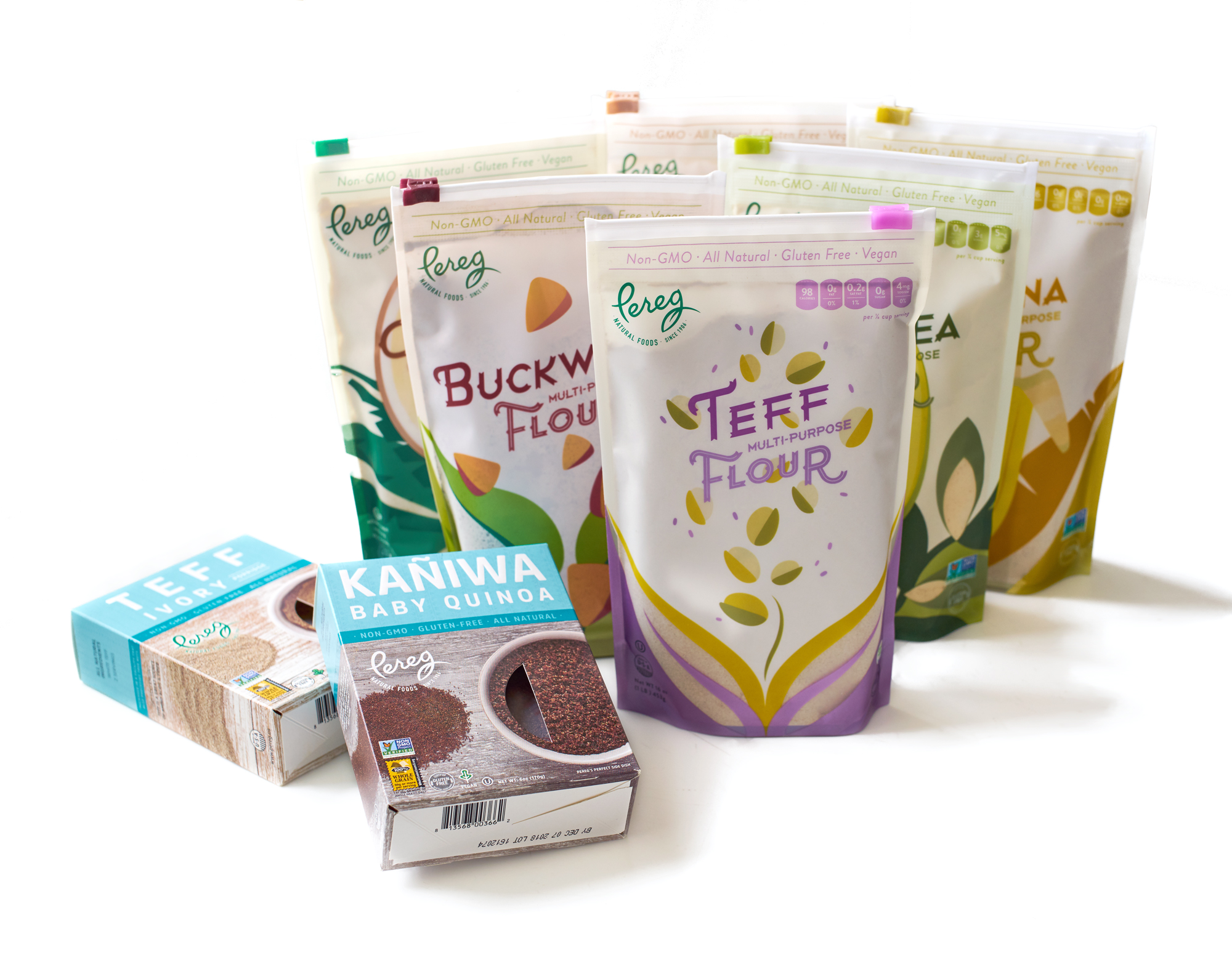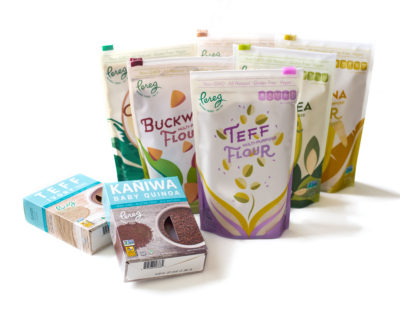PEREG Natural Foods new line of gluten-free flours are totally blowing our minds; almond, banana, buckwheat, chickpea, quinoa and coconut flours! All are certified gluten-free and non-GMO, all are 100% natural, non-dairy and certified kosher. These healthful alternatives to white flour are so delicious and unusual, they will have everyone you bake for saying “they are made out of what?!” They are packaged in 16 oz. re-sealable stay-fresh bags, retailing for about $5.

Baking with Gluten-Free Flours
It takes a little more work to get a recipe just right when it comes to baking gluten-free, but the payoff is always satisfying. Once you have a good base recipe, experiment a bit and make it your own. Since each gluten-free flour type offers its own unique flavor and baking properties, Pereg offers a guide to using these flours in your best and most flavorful culinary creations.
- Pereg Buckwheat Gluten-Free Flour – Despite the confusing name, buckwheat is gluten-free and high in fiber. Because it’s packed with essential minerals it can really boost the nutritional value of gluten-free recipes. Gluten-free buckwheat is among the top five easiest flours to work with. It can be considered a “base flour” and can be used as a large proportion of your flour blends. Use it to make crepes, pancakes, English muffins, cookies and buns, and to thicken soups, stews and sauces.
- Pereg Quinoa Gluten-Free Flour – Quinoa flour creates soft baked goods but is also a fantastic all-purpose type of flour. Quinoa flour is especially great for baking gluten-free breads because of its protein content. Since gluten is a protein, it is important to use higher protein flours (such as quinoa) to compensate for the lack of gluten when baking gluten-free. The protein in quinoa flour helps to give your bread structure, and will improve the overall texture.
- Pereg Gluten-Free Banana Flour – Because of the high starch content in banana flour you can use less flour than specified in your everyday recipes. Rule of thumb is to use 30% LESS banana flour than wheat flour. Banana flour mimics the results of wheat flour remarkably well, making for an easy transition in your everyday baking. Banana flour works well by itself, but also complements most other flours wonderfully. Made from peeled, ripe bananas, the flour has minimal taste. Once baked your final creation will have an earthy, wholesome flavor and a light and fluffy texture.
- Pereg Gluten-Free Almond Flour – When you’re baking with almond flour, remember that it does not behave like a “normal” flour. It’s much higher in fat and therefore needs some adjustments. When you bake with almond flour, you’ll notice the texture tends to be more on the tender and cake-like side, that’s because of the higher fat content. Almond flour recipes tend to use more eggs and less fat. The eggs provide more structure and moisture, but won’t give baked goods an egg-y taste! Use almond flour in small amounts. Almond flour batters are almost always thicker than traditional wheat-based or other gluten-free recipes. Refrain from adding more liquid, because if you do, your baked goods won’t bake through. Great uses are in pizza crust, shortbread cookies and chicken nugget coating.
- Pereg Gluten-Free Coconut Flour – Baking with coconut flour is like nothing you’ve ever experienced before. It’s super absorbent, but doesn’t have a lot of binding power. You’ll notice that recipes using coconut flour use a lot of eggs and very little flour. That’s because, as it lacks structure, without the addition of other ingredients to add body, it wouldn’t hold its shape well. The eggs provide moisture, act as a binder, and also give the baked goods structure. Like almond flour, if you’re new to baking with coconut flour, stick with recipes that have already been tested and proven to work. If you’re building a coconut flour recipe from scratch, a good rule of thumb is that for every 1/4 cup coconut flour in a recipe, you need to add two eggs. If you’re mixing in other dry ingredients, such as cocoa powder, your egg ratio will need to go up even higher.
- Pereg Gluten-Free Chickpea Flour – One of the constant challenges of gluten-free baking is pleasing texture. Chickpea flour is a naturally dense flour, and because of that denseness and its innate binding tendencies, chickpea flour lends baked goods a sturdy yet tender texture when mixed with other gluten-free flours. It is also one of the most nutrient-packed gluten-free flours available. It’s full of healthy protein, fiber, vitamins, and more. Use if for quick breads, muffins, and cakes. When chickpea flour is mixed with water, and warmed over medium heat, it gains a creamy, roux-like consistency giving you a velvety, dairy-like effect. Use it as a base for an array of vegan sauces, creamy dressings, and dips.
Pereg Natural Foods was established in 1906, and is based in Clifton, NJ. All Pereg products are kosher certified by both the Orthodox Union (OU) and CRC, are dairy and lactose-free as well as all natural, with no additives or preservatives. Many products are also certified gluten-free and non-GMO. Pereg Natural Foods products are available at select retailers throughout the US and Canada, and on their website, and some even on amazon!
Follow Pereg Natural Foods on Facebook.com/pereggourmet, Twitter @pereggourmet and Instagram @peregnatural.



